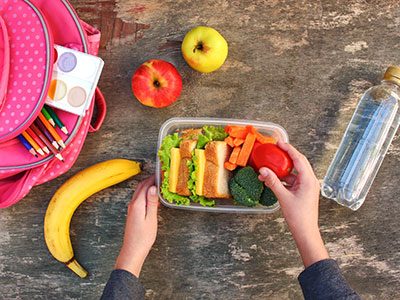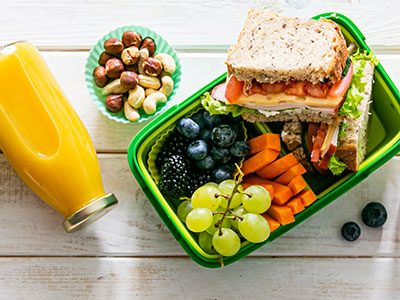Nutrition is important to the health and development of children of all ages. Now that school is back in session, the entire family can have fun creating healthy lunches. Packing a school lunch together is an opportunity for parents to model healthy eating and for children and teens to practice preparing their own meals. A healthy lunch should include a variety of foods including fruits, vegetables, water, fiber-rich items and protein. Aim to limit added sugar, including sugar sweetened beverages, desserts and sweet snacks.
A note on food allergies
Most food allergies in children are caused by six food groups: milk, eggs, peanuts, tree nuts, soy and wheat. Children should be aware of their food allergies and advised not to share food with other children. For children with suspected food allergies, avoid the identified foods and discuss the symptoms with your child’s pediatrician. For children with diagnosed food allergies, talk with your pediatrician about possibly creating an Anaphylaxis Action Plan.
School lunches for preschool-aged children
Children in this age group are often exploring their taste palate and eating new foods. With their high energy, new friends and new school setting, preschoolers may “graze” or eat small portions of food throughout the day. This may mean they bring home a half-eaten lunch, which may have parents worrying if their child is getting enough to eat.
- Involve your children in selecting their lunch choices, such as choosing between two healthy snacks options (orange or an apple).
- Try naturally flavored water or sparkling water as alternatives to sugar sweetened beverages.
- Encourage foods high in calcium, fiber and protein such as fruits, vegetables, yogurt, cheese sticks, hummus, hard boiled eggs and nut butters.
School lunches for children in grade school
As children grow older, packing their lunch can become a part of their routine they can do on their own, with supervision. They may be influenced by the lunches their peers eat, switch foods with their friends or choose food from the school menu.
- Continue to model healthy habits at home and when eating out.
- Respect your child’s evolving dietary preferences, while encouraging foods low in sodium, saturated fat and added sugar.
- When selecting food from the school menu, review it in advance and select healthier options.
School lunches for teenagers
As children transition to adolescence and young adulthood, they begin to demonstrate more independence. As their schedules become busier, they may need your guidance in making better nutrition choices.
- Start the day off with breakfast, preferably one rich in fiber and protein.
- Strongly encourage teens not to skip lunch, consider packing nutrient rich snacks and limiting processed foods.
- Avoid sugar-sweetened beverages such as sports drinks, sodas and juice.
Food and nutrition resources
MyPlate offers recipes, quizzes and tips to eat well on a budget and within your dietary needs. The School Breakfast Program and the National School Lunch Program provide millions of children in the United States with nutritious meals every day. Additionally, federal and local programs such as SNAP, WIC and Summer EBT offer supplemental food and nutrition resources for eligible families. Talk with your child’s pediatrician and/or designated school administrator to learn more.
 https://riseandshine.childrensnational.org/wp-content/uploads/2025/12/Mom-nursing-feature.jpg
300
400
Rise and Shine
https://riseandshine.childrensnational.org/wp-content/uploads/2017/11/childrens_riseandshine_logo.jpg
Rise and Shine2025-12-04 11:29:032025-12-04 11:29:03Tips for surviving your first month of breastfeeding
https://riseandshine.childrensnational.org/wp-content/uploads/2025/12/Mom-nursing-feature.jpg
300
400
Rise and Shine
https://riseandshine.childrensnational.org/wp-content/uploads/2017/11/childrens_riseandshine_logo.jpg
Rise and Shine2025-12-04 11:29:032025-12-04 11:29:03Tips for surviving your first month of breastfeeding





















Leave a Comment
Want to join the discussion?Feel free to contribute!